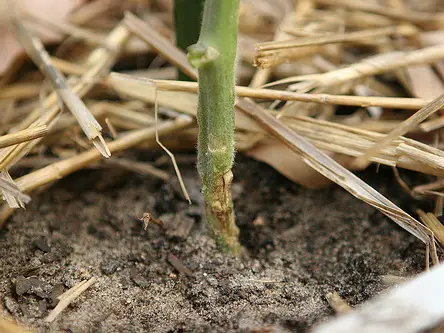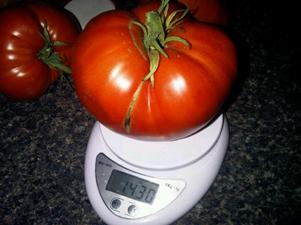| Back to Back Issues Page | |||||||||
 |
|||||||||
|
[Tomato Dirt] Beware of These 5 Tomato Problems in New Plants May 29, 2013 |
|||||||||
Tomato Dirt Newsletter
|
Tomato Dirt is on Pinterest!
Join us on Pinterest! Browse our 25+ boards for all kinds of tomato inspiration and practical information: cool tomato gardens, tomatoes just off the vine, different tomato varieties, tomato art – even gardening quotes. Check our our page. Happy pinning!

FEATURE: Beware of These 5 Tomato Problems on New Plants
Once your tomato plants are in their new homes in the garden, your work is not over. Take the time at least once or twice a day to check for these 5 warning signs that can indicate a tomato problem.
 |
Cutworm damage (Image: The Conservative Gardener) |
1. Chopped stems
Cutworms gobble up stems of newly-planted tomato seedlings, usually at night, cutting off seedlings at the soil line. But you can keep away cutworm larvae when you place collars around tomatoes as you set them in the garden (here’s how.)
2. Missing or chopped leaves
Chances are you’ll see the effects of the tomato hornworm before you find the culprit itself. Hornworms feast on tomato leaves, fruit, and even stems, starting at the top of the plant. They like to hide on the undersides of lower remaining leaves and munch their way through several meals, often in the dark of the night.
3. Wilted, dropped leaves
Aphids are among the earliest tomato snackers in the garden. These tiny (less than 1/8” long) pests attack the tip of the stems and the leaves, sucking out plant sap. Affected plants may wilt, drop leaves, or have yellowing leaves. Take these steps to get rid of aphids.
4. Too many healthy leaves
Huh – this is a problem? Let me set the record straight: yes, you do want to see vibrant, new growth on your plant as soon as it adjusts to its new home. But if your tomato plant is tall, extremely dark green, overflowing with leafy growth – but has few to no blossoms during the period its variety is supposed to start flowering – chances are good that you’ve inadvertently used a fertilizer with too much nitrogen, which is known to promote leaf growth. Use a fertilizer balanced for tomatoes instead. Phosphorus (the second number in the N-P-K ratio) encourages flowering, and therefore fruiting. Once a tomato plant starts flowering, it needs a higher ratio of potassium (the third number in the N-P-K ratio).
5. Yellowed leaves near the base of the plant
Lower leaves on newly-planted tomatoes may naturally yellow and drop in response to transplant shock. But keep your eye on plants. Yellowing leaves can be a sign of different kinds of blight. Reduce onset or even keep it at bay with a fungicide regimen.
-----------------------------------------------------------------
Introducing … Tomato Masters Bragging Rights Competition
 |
Image: www.bugvibes.com |
Tomato Dirt introduces Tomato Masters … a friendly competition among tomato gardeners as we cheer each other on to tomato-growing success.
Our idea is simple. Tomato gardeners are a sociable and supportive bunch. We like seeing others’ gardens and produce. It’s fun to share with each other, learn from each other, and admire each others’ tomatoes.
So here’s the dirt. Our first series of Tomato Masters Bragging Rights will go to the gardener who sends us documentation of largest tomato, by weight.
During this first go-round, we will give 3 awards:
Tomato Master Bragging Rights June 2013
Tomato Master Bragging Rights July 2013
Tomato Master Bragging Rights August 2013
Start planning your picking-and-photographing strategy now!
Read all the details and how to enter on our new Tomato Masters page.
--------------------------------------------------------------
More Tomato Problems to Watch For
| How to Identify Tomato Problems and Prevent Them | Are you watering tomatoes enough? | Blossom End Rot: How to Identify, Treat, and Prevent It | How to Identify Tomato Pests and Control Them |
|---|
That’s it for now. More next time!
Until then, happy gardening!
![]()
Kathy with Tomato Dirt
www.tomatodirt.com
Find us on Facebook!
